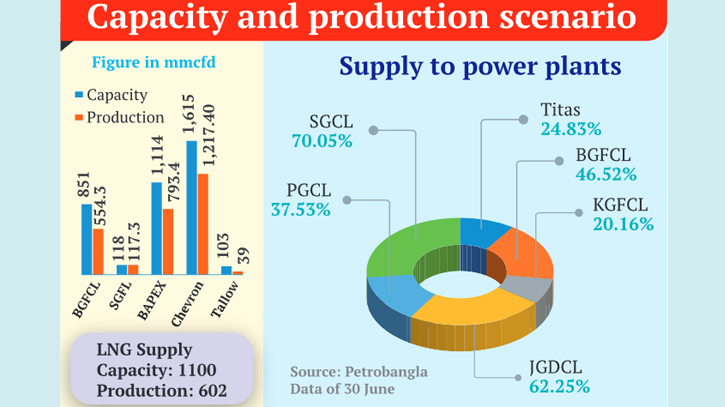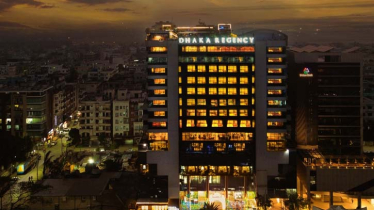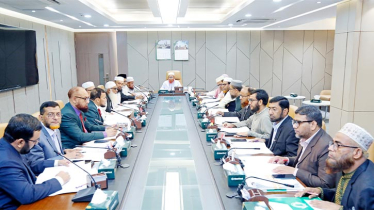
Photo: Messenger
Supply of gas has been dropped by 32 percent as production is depleting and LNG import has been cut by 50 percent due to fund crisis. Resulting, the power plants and household consumers are experiencing severe gas crisis.
Dwellers of different areas of capital city cannot cook properly while power production drops to 12,965 MW from 15,500 MW as gas production down to 2,611mmcfd against demand 4,000mmcfd.
Muhammadpur, Mirpur, Bonosree, Dhanmondi and other areas of dwellers are facing the crisis in different time especially during cooking time.
Aniruddho Rony, resident from Mohammadpur could not lunch on Monday noon as his wife cannot cook due to gas crisis. He told the Daily Messenger “I took lunch in hotel as we cannot cook food. Gas pressure increases after 12 am at night.”
Najer Hossain living in Kawla cook by induction stove as gas is not available in day time. He said “We use electric induction stove because we both husband and wife are office going, so need gas supply on cooking time but we don’t have the supply.”
“Recently, the FSRU, owned and operated by Summit Group, came back from the maintenance programme We hope it will resume operation by this month as per schedule,” Engr. Md. Kamruzzaman Khan,
Director (Operation & Mines) of Petrobangla told the Daily Messenger.
He also said resuming operation of the Summit’s FSRU will increase the gas supply by 600 MMCFD to the national grid which will improve the overall supply situation.
He said currently, Petrobangla can get a maximum 650 MMCFD gas supply from one FSRU. “But after Summit FSRU’s resumption of supply, we will get 1100-1150 MMCFD gas,” he added.
Petrobangla officials, however, said despite the Summit FSRU’s comeback, the country will continue to suffer from the gas crisis as there will remain a huge gap between gas demand and supply.
Currently, Bangladesh Gas Field Company Ltd is producing 554.3 mmcfd against capacity 851 mmcfd, Sylhet Gas Field producing 117.3 mmcfd against capacity 118 mmcfd, BAPEX producing 793.4 mmcfd against 1,114 mmcfd, Chevron producing 1,217.4 mmcfd against 1,615 mmcfd capacity, Tallow producing 39 mmcfd against 103 mmcfd capacity and LNG production cut to 602 mmcfd from 1,100mmcfd.
And the distribution companies also cut the supply of gas to the grid drastically. Titas gas now supplying 221.5 mmcfd of gas to the power plants against the demand 892 mmcfd, Bangladesh Gas Distribution Company Ltd (BGDCL) supplying 197.2 mmcdf against demand 423.9 mmcfd, Khulna Gas Distribution Company LTD 37.3 mmcfd against 185 mmcfd, Paschimanchal Gas Company Limited (PGCL) 92.7 mmcfd aganst 247 mmcfd, Jalalabad Gas Transmission and Distribution System Limited supply 245.9 mmcfd against 395 mmcfd demand, Sundarban Gas Company Limited supply 121.9 mmcfd against 174 mmcfd demand.
Industries in Dhaka, Gazipur and Narayanganj have been experiencing an acute gas shortage for long due to the shortage in supply.
Most of the industries in Gazipur do not get adequate supply of gas during their operational periods, the most crucial hours during which their machines need to be running. Inadequate supply manifests in the form of low-pressure gas flow.
Low pressure gas flow is akin to low voltage electricity - many appliances won't run, even though an electric charge is present.
Due to the lack of gas supply, production in various factories is being disrupted and some are on the verge of shutting down.
In the ongoing gas crisis, important machines like generators and broilers in the dyeing section of the factories are not operating. This has been posing a great risk for the industries to continue their production and pushing them towards huge financial losses.
Messenger/Disha








